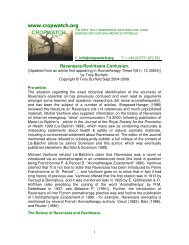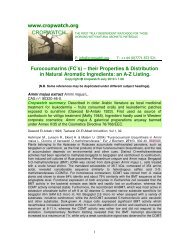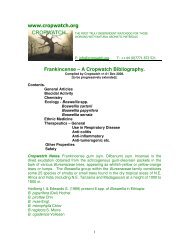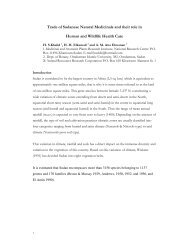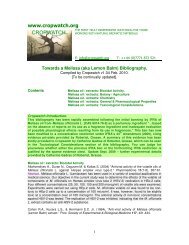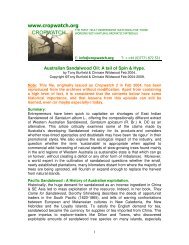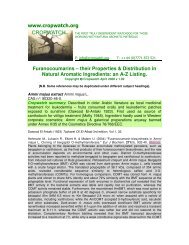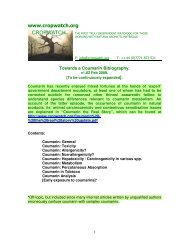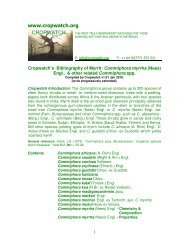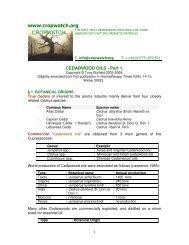Sandalwood Biblio - Cropwatch
Sandalwood Biblio - Cropwatch
Sandalwood Biblio - Cropwatch
You also want an ePaper? Increase the reach of your titles
YUMPU automatically turns print PDFs into web optimized ePapers that Google loves.
characterized using^sup 1^H-,^sup 13^C-NM MR, GC/FTIR and GC/MS analyses. <strong>Cropwatch</strong><br />
comments: The authors show lower concentration of cis- alpha santalol & cis-beta santalol,<br />
higher conc of (Z) trans-alpha bergamotol & epi-beta-santalol in the oils of S. spicatum compared<br />
with S. album. Regarding the bisabolols, the main isomer in S. spicatum is 6R, 7S-epi-betabisabolol<br />
whereas in S album it is 6R, 7S-beta-bisabolol. The oils should therefore be regarded<br />
as different<br />
Valder C., Neugebauer M., Meier M., Kohlenberg B., Hammerschmidt F.-J., Braun N.A. (2003a)<br />
“Santalum spicatum (R.Br.) A DC. (Santalaceae) – nor-helifolenal & acorenol Isomers: Isolation<br />
and biogenic considerations” J. Essent. Oil Res. 15, 381-386.<br />
Wedding B.B., White R.D., Grauf S., Tilse B., & Gadek P.A. (2009) “Near infrared spectroscopy<br />
as a rapid, non-invasive method for sandalwood oil determination.” Papers from the 11th Society<br />
for the Advancement of Breeding Research in Asia & Oceania Congress (SABRAO) In: 11th<br />
Society for the Advancement of Breeding Research in Asia & Oceania Congress (SABRAO), 10-<br />
14 August 2009, Cairns, QLD, Australia. Abstract. Fourier Transform (FT) - near infra-red<br />
spectroscopy (NIRS) was investigated as a non-invasive technique for predicting -santalol<br />
content in sandalwood chip samples. The correlation between the NIR spectral data and the a-<br />
santalol content from the GC-MS analysis was very high (R2 = 0.93). The feasibility study<br />
indicates that it is possible to use FT-NIRS to predict -santalol content in sandalwood chip<br />
samples. The technique of utilising NIRS technology for sandalwood quality and quantity<br />
determination needs to be further developed to be utilised as a tool for commercial applications.<br />
Australian <strong>Sandalwood</strong>s - General<br />
Anon (1919) “Western Australian sandalwood oil. An official statement on the products.” Perff<br />
Essen Oil Record 10(7), 194-195.<br />
Anon (1998) Australian <strong>Sandalwood</strong> oil. A new century – a new alternative. Mount Romance<br />
Australia Pty Ltd. Albany, Western Australia.<br />
Anon (2000) “Qld: Five fined for sandalwood harvesting” AAP General News Perth (Australia)<br />
Dec 12th WA: sandalwood claims would be dealt with if true: Abstract Court story alleging that<br />
West Australian government officials were exporting sandalwood to dealers in Taiwan who had<br />
offered state officials bribes or prostitutes.<br />
Anon (2002) AAP General News (Australia) Nov 18 (2002). Abstract: Five people fined in the<br />
Cairns Magistrate Court for illegal harvesting of the protected sandalwood plant, the Queensland<br />
EPA reportedly said.<br />
Anon (2002) “A Crop in Crisis” – a part of “A calming influence” Soap, Perfumery & Cosmetics<br />
(Oct 2002) p42-3.<br />
Anon (2006) "Big expansion for sandalwood plantation." ABC Newsonline Abstract 19th June<br />
2006. An Indian sandalwood plantation in the Ord Valley is undergoing its biggest expansion in<br />
seven years. Tropical Forestry Services is planting a further 235 hectares of the exotic hardwood,<br />
increasing its total plantation to more than 800 hectares. The company plans to harvest its first<br />
crop in 2012, banking on continuing strong demand from Asia, Europe and the United States.<br />
Chief executive Tom Cullity says the company is planning processing facilities at Kununurra to<br />
produce sandalwood oil which is used for perfumes and cosmetics. "Oil is from the hardwood.<br />
Over $100,000 Australian for a tonne of hardwood. The sandalwood oil that is distilled from the<br />
hardwood is very valuable and it's used in a lot of perfumes and cosmetics," he said. The other<br />
major grower of indian sandalwood in the Ord, ITC Limited, has now planted 750 hectares,<br />
owned by investors.Its first harvest is planned for 2014.<br />
Anon (2007) “W.A. <strong>Sandalwood</strong> set to dominate world trade.” ABC News 11/12/2007. Abstract.<br />
The head of one of the world's leading fragrance companies believes the Ord Valley in Western<br />
Australia will overtake India, as the major producer of Indian sandalwood. The Ord has the only<br />
6





